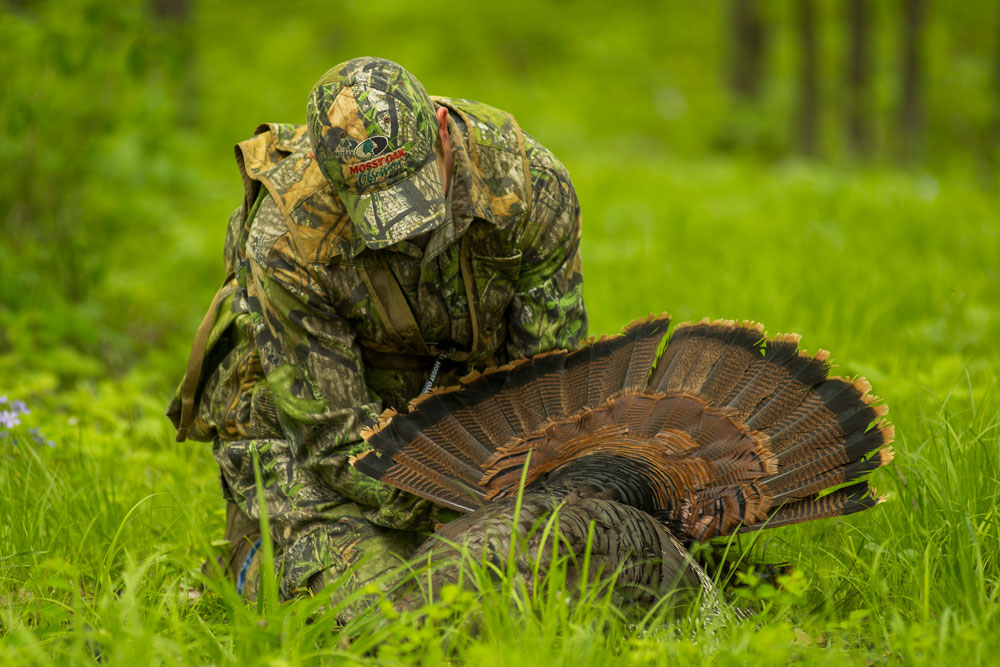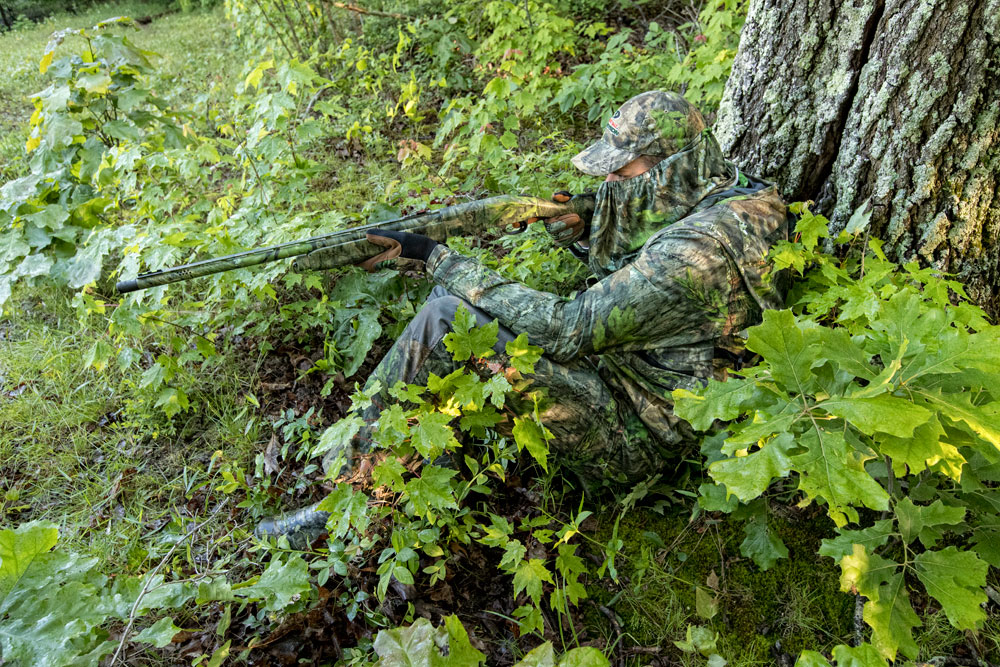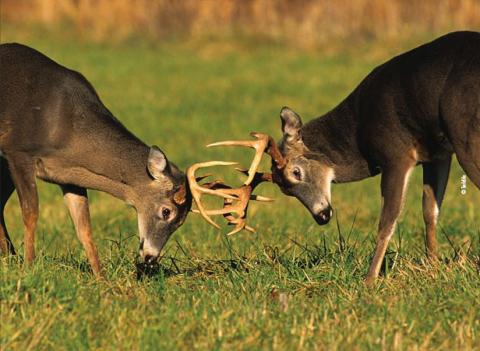Scott Ellis
The wild turkey can offer the hunter one of the greatest challenges of any of the North American game species. Consistently bagging turkeys every season entails putting forth your best hunting efforts, embodying stealthy movement and putting yourself in a predatory mode. Luck has its place in every hunter’s endeavors but it is impossible to be consistently lucky. Placing your frame of mind on constant alertness will enable you to heighten your awareness and your woods skills. Letting your guard down for one minute can be the difference between filling your tag and heading home empty handed.
Movement and Noise:
The average hunter lumbers through the wood with no regard to the wildlife he is alerting to his presence. Trudging onward snapping limbs and twigs with every step. The hunter himself is often his own worst enemy. The hunt is very frequently over before it ever begins due to the lack of caution when moving through the woods.
Running and gunning is a very effective method of hunting turkeys, but one should constantly be monitoring his noise and movement levels. Envision a cougar stalking a flock of turkeys. It moves at a snails pace in a prone position. It covers little ground in rapid fashion, using available cover to mask its movement. Throughout the years of my turkey hunting endeavors I have moved on turkeys in the same manner, even when just to reposition and try calling from a different angle. Allow yourself more time to move from point A to point B. Using available cover to conceal your movement will also put you on the path to success. When making your way through the timber, pick the path that will offer the most concealment and the least amount of noise.
Patience:

One of the most overlooked factors of consistently successful turkey hunters is the ability to sit still for extended periods of time. We all know there are two basic methods to hunt turkeys, blind calling and running and gunning. The key is that both methods are directly affected by having the patience to remain stationary when needed. Exhibiting the ability to wait out that old gobbler will have turkeys riding in your vest on a regular basis.
Blind calling consists of setting up and calling in a stationary position, with hopes a gobbler will come within earshot of your lusty turkey hen vernacular. When all the hens have been bred and the toms are on the move, it is common to locate gobblers that are still in a heightened state of breeding. Setting up on an early spring food source or any other area that you have noticed high hen traffic is key. The gobblers will frequent these areas not only to feed, but because he may ultimately find a breeding partner that has been overlooked.
Patience does not apply to running and gunning directly, but once you have engaged in a conversation with a gobbler, moving too hastily can prove to be detrimental to your efforts. Once you start working a gobbler, do not change your position unless absolutely necessary. Each year many gobblers would have been harvested had the hunter remained still. When a gobbler goes silent there is a very good possibility he is closing in quietly. A simple rule of thumb is when you have decided to get up and move, wait 20 more minutes. If the gobbler is continuing to answer you but noticeably heading the other direction, only then should you reposition. Try an approach from either another angle or get around in front of his travel route and engage him.
Awareness/Keeping Up Your Guard:
Heightening your overall woods awareness and always being on the defense is one factor to consider. Learn to decipher certain turkey sounds and vocabulary while on your hunt. Listen for scratching, soft deliberate foot steps in brittle leaves or the long distance sound of a yelp or a single cluck. The key here is tuning your senses to pick up on these turkey identifiers. Often times hunters overlook these simple tell tale signs that there are turkeys in their area. When you are in turkey rich environment always feel there are turkeys within eyesight of your position. Taking care when any movement is involved will allow you to view more game, turkey or otherwise. Scan your field of view only cutting your eyes from left to right. Use your peripheral vision to its maximum potential before any head movement. When you decide to move your head or shift your body for a better view, use slow deliberate movement.
Turkey Behavior:
The wild turkey has certain behavioral patterns they adhere to. Take the time to verse yourself on which patterns will affect you during the spring. Plan as many scouting trips to the areas you will frequent during the upcoming spring season. This will allow you to gauge those particular turkeys. Learn their habits and whereabouts, ranging from just after fly down, mid morning, mid and late afternoon. Having the ability to locate turkeys during these time frames will give you an added advantage.
Learn as much as possible about the wild turkey from a biological standpoint. For example, social structure, breeding and feeding habits, nesting and roosting areas. Patterning turkeys and identifying which part of the breeding cycle the turkeys are in will help you modify your tactics throughout the spring season. Each year will present a new set of challenges. The season could start off with the gobbler already having assembled his harem and is roosting with them daily. You may also encounter a scenario where the tom is more vocal on the roost having not yet assembled his hens. If it is later in the season and you have identified the hen’s are nesting you will then know that running and gunning will be highly effective as the gobblers are on the prowl searching for any willing ladies. There are many situations and time frames to consider. Identifying which phase of their spring courtship is occurring will aid in you choice of tactics.
Concealment:

Mother Nature designed her predators well. They utilize their fur color or plumage for their concealment. They also exploit the terrain and the available cover to cloak their attacks. The turkey hunter can apply these same tactics to his hunting. Use any available natural cover to disguise your position. Although the advent of pop up blinds has become wildly popular as of late, I prefer to use what Mother Nature provides for my concealment. Deadfalls, palmettos, brush and even the natural contours of wood lines provide excellent concealment.
Your use of camouflage is very important as well. Depending on early or late spring, match your patterns to your surroundings. There are countless numbers of excellent camo patterns on the market today. Chose the one that best suits the terrain you are consistently hunting. This can also change from early to late spring as the amount of foliage and color appears as the season progresses.
Turkeys will key in on movement before anything else. As, stated previously make sure you remain still as long as possible and when movement is necessary use slow, calculated motion. Granted, you can harvest turkeys in blue jeans, if it tickles your fancy. I prefer to capitalize on any advantage that aids in my concealment.
In Conclusion:
The wild turkey is a formidable opponent. His senses and instincts are his number one defense. It is not that he is smarter than the average turkey hunter; it’s just the fact that capitalizes on his uncanny abilities. The turkey hunter must act in the same fashion. We must exploit the same God-given instincts that are buried somewhere inside us all. Always remember we are the highest rung on food chain ladder. We are the most intelligent creatures that scour the earth. Discipline, caution, woods awareness and attention to detail are the ingredients to become a turkey predator.





























